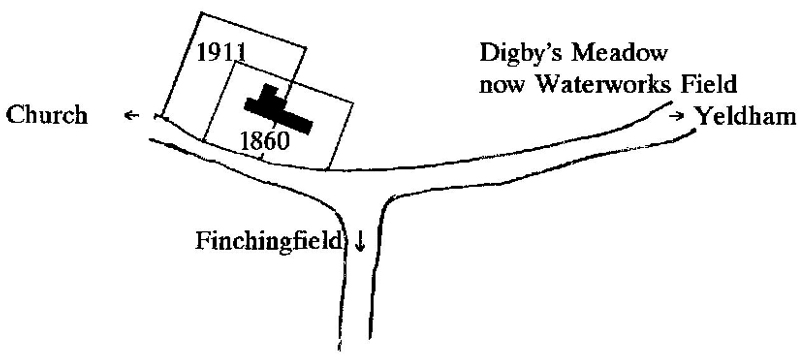Stambourne Church of England School & the Frys 1861-1958
This is a transcript of notes made on 21 April 1994 in Barclays Bank in Haverhill after Derrick Johnson had arranged with Alan King (probably deputy manager) to show us the deeds. It includes some notes of my own & information from the DNB.
The seminal document is a parchment 27” x 20” which is dated on one side 25 June 1860 & on the other bears an indenture of 19 December 1911.
There is a number of other deeds and transfers in typescript relating mainly to the closure and conversion to Village Hall which will bear later study but would require a day’s work at home.
The original 1860 transfer is confusingly endorsed with a stamp of 1859 while the perceived date of the school’s opening is 1861. It is of the grant of a nearly square plot of land in the Western corner of the lands of the Hall adjoining what was then Digby’s Meadow. This is now identified as the waterworks field and is the property of J Shand of Essex Hall. The plot was probably woodland.
The transfer is from
- Francis E Gibson
- Lewis Fry
- Elizabeth Pease (who subscribes herself Elizabeth P Fry)
And is to the church officers
- John Forster (Rector here 1858-68)
- William Ruffle &
- Robert E Smith (his wardens)
with verbose references to the Bishop of the diocese.

In the text, which is faded and difficult to read but in a clear document manuscript, the names of several villagers are scattered:
- Lewis Lewsey – Publican
- William Marsh – Yeoman
- George Ruffle – Farmer
- Joseph Choat Jarvis – Shopkeeper
The central panel of the reverse (originally the front) is the title of the deed with the later date of 19 December 1911 added. This relates to an INDENTURE that is fitted into the spaces around the panel. It transfers an L-shaped enlargement of land belonging to the Hall from:
- Lewis Fry (now Right Honourable but he is not in the DNB)
to:
- J H Brookes (Rector here 1896-1919; I don’t recall if his names were given)
- Elizabeth Unwin &
- John Joseph Since or Cince (his wardens)
It is witnessed by, inter alia,
- Richard Fry – Chocolate maker of Bristol
- Abrham (sic) Ashard – servant to Forster (sic)
- A M – Butler of Bristol
Biographical note
The original Fry – a Joseph – seems to have been 1728-1787, who invented a type fount which he said was like Caxton’s and who also called himself a Cocoa Maker. Another Joseph Fry married Elizabeth Gurney in 1800 – he could have been a grandson – it seems the prison reformeress (1780-1845) was related to cocoa money, therefore Joseph Storrs Fry (1826-1913) was the major chocolate man and the philanthropist.
Clearly Joseph was the mainstream name but our Lewis Frys (probably 3 generations) are also clearly of the same ilk: as shown by their getting Richard, the self-styled chocolate maker of Bristol, all the way up here to witness the disposal of family land.
So an Elizabeth Fry did indeed live in Stambourne, but she was neé Pease, not Gurney and lived about 1830-90, not 1780 to 1845.
Return to Chapter 6 – Lay governance and buildings